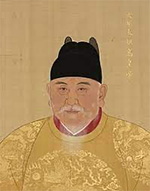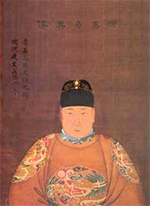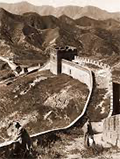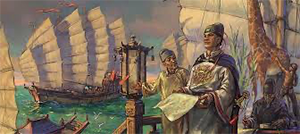China's Yongle Emperor
Zhu Di, the Yongle Emperor, was one of China's most famous rulers. The third of the Ming Dynasty emperors, he expanded Chinese prosperity and prestige around the world, and his reign is considered by many to be a Golden Age. 
Taizu, the Hongwu Emperor (right), founded the Ming Dynasty in 1328. He lived a long life and had many successes and, naturally, had in mind that subsequent emperors would perpetuate those successes. Zhu Biao, as Crown Prince Yiwen, was designated successor to Taizu. Zhu Biao, however, died in 1392, while Taizu was still on the throne. The emperor's second son, Zhu Shuang, and third son, Zhu Gang, also predeceased their father, dying in 1395 and 1398, respectively. (Zhu Gang died only two months before his father did.) Thus, the oldest surviving son of Taizu when that emperor died was Zhu Di, his fourth son. However, Taizu named as his successor his grandson Zhu Yunwen, the oldest surviving son of Taizu's oldest son, Zhu Biao. Thus, Zhu Yunwen became the Jianwen Emperor. 
Distrustful of his surviving uncles (who included not only his father's remaining sons, Zhu Di and Zhu Su, but also a handful of other sons of his father by other mothers), the Jianwen Emperor (left) scaled back their power base and limited their influence. His suspicions proved correct, as Zhu Di led an insurrection against the new emperor, known as the Jingnan Campaign. The two sides struggled for supremacy for a few years, with the emperor ordering Zhu Di's arrest and the latter's escaping capture. Zhu Di gradually turned enough people against his nephew to gain the upper hand and then delivered a military victory as well, capturing a government fleet and seizing control of Nanjing, the capital. The victorious Zhu Di, in 1402, ordered the capital grounds burned and then presented to the public at large the charred remains of three people, which Zhu Di claimed were the Jianwen Emperor and his wife, Empress Xiaominrang, and son, Zhu Wenkui.  Zhu Di then declared himself the Yongle Emperor, the rightful successor to Taizu, and ascended the Ming throne. One tradition has it that the young former emperor escaped persecution and went into hiding, living out his life in obscurity, perhaps in a monastery. In any case, he was not heard from again. His ascension complete, Zhu Di, commonly known as Chengzu, got on with ruling the empire, in large part initially by doing away with the opposition. As had his father before him, the Yongle Emperor found many reasons to distrust anyone who had supported his nephew and predecessor and so set about executing such dissidents, including the widely respected scholar Fang Xiarou, whose offense was being a tutor to the Jianwen Emperor. Chengzu extended that persecution to every student, past or present, of Fang Xiarou that government agents could track down. Many, many people died in these purges. The emperor then set up a spy network to limit such dissidence. Imperial distrust of dissent within did not extend to dissuading external expansion, however. Reversing the isolationist policies of his father, Chengzu looked to expand Chinese understanding of the rest of the world and, at the same time, increase other civilizations' admiration for China. The most visible of those initiatives might have been the voyages of Zheng He and his large fleet. On seven In the same vein, Chengzu cast his eye southward, conquering part of what is now Vietnam but failing to succeed in another, related venture. 
Chengzu's father had driven the remnants of the Yuan Dynasty supporters out of the northern part of the realm, but the Mongols had not gone away. In order to protect against another Mongol invasion, Chengzu moved his capital from Nanjing to Beiping (now Beijing), his former seat of power when he was ruling the north for his father, and ordered the Great Wall rebuilt and reinforced. In order to encourage greater internal trade, the emperor ordered an upgrade of the Grand Canal. The 1,100-mile-long waterway had its origins during the 6th Century Sui Dynasty but had fallen into disrepair. Perhaps the most long-lasting of Chengzu's programs was the construction, between 1406 and 1420, of the Forbidden City, a huge compound of imposing buildings, halls, gardens, bridges, pagodas, and canals–all enclosed by high walls. He also designed and ordered built the Porcelain Tower of Nanjing, a 260-foot-tall octagonal wonder that featured nine stories linked by an interior spiral staircase. The tower's white porcelain bricks reflected sun rays during the day, and workers lit more than 100 lamps at night to show off the tower in darkness. Despite his purge of opposition intellectuals, the emperor was very much a scholar himself and installed his own litany of scholars, not only in his government but also in the prestigious Hanlin Academy. Another legacy- Great Wall or not, the Mongols continued to threaten, and Chengzu again found himself on campaign. It was 1424 and the fifth time that the emperor had led his army against enemy forces. It proved to be his last. He died, at 64, of illness and his oldest son, Zhu Gaochi, succeeded him, becoming the Hongxi Emperor.
|
|
Social Studies for Kids
copyright 2002–2025
David White



 expansive voyages from 1405 to 1433, they sailed into the South Pacific, the Indian Ocean, the Persian Gulf, and along the east coast of Africa. In exchange for deliveries of Chinese silk and Ming porcelain, civilizations far and wide agreed to maintain the Chinese tribute system. Among the exotic elements that Zheng He and his sailors brought back home from these voyages were giraffes and theretofore unknown gems and spices.
expansive voyages from 1405 to 1433, they sailed into the South Pacific, the Indian Ocean, the Persian Gulf, and along the east coast of Africa. In exchange for deliveries of Chinese silk and Ming porcelain, civilizations far and wide agreed to maintain the Chinese tribute system. Among the exotic elements that Zheng He and his sailors brought back home from these voyages were giraffes and theretofore unknown gems and spices. building exercise from Chengzu was the commission of the creation of the Yongle Dadian, a very, very large encyclopedia that involved thousands of scholars, most from the Hanlin Academy, producing what amounted to 22,000 chapters of literary works that spanned the entirety of the civilization. Subjects covered were many: agriculture, art, astronomy, drama, geology, history, medicine, science, and technology, as well as art and religion. Despite the advent and popularity of printing, this book was done by hand.
building exercise from Chengzu was the commission of the creation of the Yongle Dadian, a very, very large encyclopedia that involved thousands of scholars, most from the Hanlin Academy, producing what amounted to 22,000 chapters of literary works that spanned the entirety of the civilization. Subjects covered were many: agriculture, art, astronomy, drama, geology, history, medicine, science, and technology, as well as art and religion. Despite the advent and popularity of printing, this book was done by hand.
